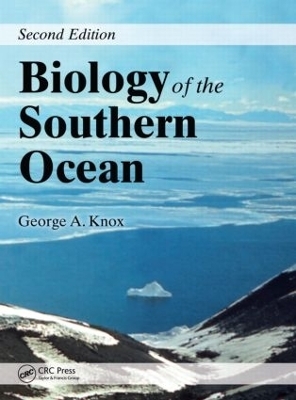
Biology of the Southern Ocean
Seiten
2006
|
2nd edition
Crc Press Inc (Verlag)
978-0-8493-3394-1 (ISBN)
Crc Press Inc (Verlag)
978-0-8493-3394-1 (ISBN)
Covers phytoplankton and primary production, the sea ice microbial communities, and the secondary consumers, the zooplankton. This book describes the biology and ecology of Antarctic krill that highlights its central position in the Southern Ocean food web.
First published in 1993, The Biology of the Southern Ocean has been referred to as international research at its best and an invaluable reference. Drawing on the considerable volume of information published in the last ten years, this second edition retains the format that made the first edition a popular bestseller, while updating the information with the latest research results available.
The book begins with a description of the physico-chemical environment and, in a logical sequence, covers phytoplankton and primary production, the sea ice microbial communities and the secondary consumers, the zooplankton. The author includes an extended chapter on the biology and ecology of Antarctic krill that highlights its central position in the Southern Ocean food web. A series of chapters consider the higher consumers, nekton (with an emphasis on cephalopods) fish, seals, whales, and seabirds. The following chapters explore selected ecosystem components; the benthic communities, life beneath the fast ice and ice shelves, recent advances in understanding decomposition processes, and the role of bacteria and protozoa.
The author synthesizes ecosystem dynamics, with an emphasis on the pelagic ecosystem. He covers resource exploitation, the impact of such exploitation on the marine ecosystem, and the problems involved in the management of the living resources. His epilogue summarizes the extent to which our understanding of the functioning of the Antarctic marine ecosystem has changed in the last 50 years; for example, there has been a dramatic change in our view of krill and its role in the Southern Ocean marine ecosystem. The book concludes with the statement that research carried out under the AGCS Programme and the Scientific Committee on Antarctic Research (SCAR) will continue to provide critical information on the functioning of Antarctic marine ecosystems.
Intended for all those with an ongoing interest in Antarctic research, conservation, and management, this volume represents one of the most authoritative resources in the field as it covers all aspects of this important marine ecosystem.
First published in 1993, The Biology of the Southern Ocean has been referred to as international research at its best and an invaluable reference. Drawing on the considerable volume of information published in the last ten years, this second edition retains the format that made the first edition a popular bestseller, while updating the information with the latest research results available.
The book begins with a description of the physico-chemical environment and, in a logical sequence, covers phytoplankton and primary production, the sea ice microbial communities and the secondary consumers, the zooplankton. The author includes an extended chapter on the biology and ecology of Antarctic krill that highlights its central position in the Southern Ocean food web. A series of chapters consider the higher consumers, nekton (with an emphasis on cephalopods) fish, seals, whales, and seabirds. The following chapters explore selected ecosystem components; the benthic communities, life beneath the fast ice and ice shelves, recent advances in understanding decomposition processes, and the role of bacteria and protozoa.
The author synthesizes ecosystem dynamics, with an emphasis on the pelagic ecosystem. He covers resource exploitation, the impact of such exploitation on the marine ecosystem, and the problems involved in the management of the living resources. His epilogue summarizes the extent to which our understanding of the functioning of the Antarctic marine ecosystem has changed in the last 50 years; for example, there has been a dramatic change in our view of krill and its role in the Southern Ocean marine ecosystem. The book concludes with the statement that research carried out under the AGCS Programme and the Scientific Committee on Antarctic Research (SCAR) will continue to provide critical information on the functioning of Antarctic marine ecosystems.
Intended for all those with an ongoing interest in Antarctic research, conservation, and management, this volume represents one of the most authoritative resources in the field as it covers all aspects of this important marine ecosystem.
George A. Knox
The Southern Ocean. Phytoplankton and Primary Production. Sea Ice Microbial Communities. Zooplankton. Krill. Nekton. Fish. Seals. Whales. Birds. Benthic Communities. The Fast Ice and Ice Shelves. Ice Edge Processes. Decomposition and the Roles of Bacteria and Protozoa. Ecosystem Dynamics. Resource Exploitation. Ecosystem Changes Resulting from Resource Exploitation. Management of the Living Resources.
| Erscheint lt. Verlag | 13.12.2006 |
|---|---|
| Reihe/Serie | CRC Marine Biology Series |
| Zusatzinfo | 93 Tables, black and white; 10 Halftones, black and white; 291 Illustrations, black and white |
| Verlagsort | Bosa Roca |
| Sprache | englisch |
| Maße | 210 x 280 mm |
| Gewicht | 1700 g |
| Themenwelt | Naturwissenschaften ► Biologie ► Limnologie / Meeresbiologie |
| ISBN-10 | 0-8493-3394-6 / 0849333946 |
| ISBN-13 | 978-0-8493-3394-1 / 9780849333941 |
| Zustand | Neuware |
| Haben Sie eine Frage zum Produkt? |
Mehr entdecken
aus dem Bereich
aus dem Bereich
Naturerfahrungen zwischen Quelle, See und Wildfluss
Buch | Hardcover (2024)
Verlag Anton Pustet Salzburg
CHF 41,95
Buch | Hardcover (2022)
National Geographic Deutschland (Verlag)
CHF 55,95


